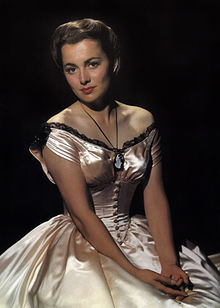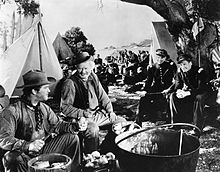Santa Fe Trail (film)
"Jeb" Stuart, Olivia de Havilland, Raymond Massey as John Brown, Ronald Reagan as George Armstrong Custer and Alan Hale.
Written by Robert Buckner, the film is critical of the abolitionist John Brown and his controversial campaign against slavery before the American Civil War.
In a subplot, Jeb Stuart and George Armstrong Custer—who are depicted as friends from the same West Point graduating class—compete for the hand of Kit Carson Holliday.
At West Point Military Academy in 1854, cadet Carl Rader (Van Heflin), an agent of John Brown, is dishonorably discharged for instigating a brawl among the cadets after distributing anti-slavery pamphlets which his classmates disapprove of—due to the controversial nature of the pamphlets (some believed the issue of slavery to be one that would inevitably resolve itself) and the U.S. Army's position against the pursuit of ideological causes while serving.
Following the brawl, Rader's classmates Jeb Stuart (Errol Flynn) and George Custer (Ronald Reagan) become second lieutenants and are posted to Fort Leavenworth, Kansas Territory, the most dangerous duty in the Army—an assignment they relish.
On the way to Kansas, Custer and Stuart meet Cyrus K. Holliday, in charge of building the railroad to Santa Fe, New Mexico, and his daughter Kit (Olivia de Havilland), with whom both officers fall in love.
In disguise, Stuart rides into Palmyra, the center of the Underground Railroad, but Brown's men spot his horse's army brand.
Attempting to escape, Stuart is trapped in a burning barn but is saved as Custer leads the cavalry to the rescue, driving Brown into seclusion.
[13] The film was premiered in Santa Fe over a three-day festival, featuring a large number of celebrities, including Flynn, De Havilland, Rudy Vallée and Wayne Morris.
[14][15][16] There were 250 guests and two special trains, one from Hollywood and one from the East, for a total cost of $50,000 — shared between Warners and Santa Fe Railroad[17] De Havilland was stricken with appendicitis during the trip and had to be flown home.
This film takes substantial liberties with other historical facts: To this day, some historians describe the figure of John Brown as a monomaniacal zealot, others as a hero for his violent tactics in the name of emancipation.
In the film, Brown eagerly endorses breaking apart the union of the United States and further bloodshed as a means to bringing an end to slavery, ultimately seeing his own demise as a sacrifice made to further the cause of abolition.
The film seems to place blame for the outbreak of the Civil War on John Brown and the abolitionists perpetuating the violence of the Pottawatomie Massacre in Bleeding Kansas, but many other factors over a longer period of time.
In many scenes, including one with a Native American fortune teller, the heroic protagonists are unable to foresee how the issue of slavery could make them bitter enemies in the near future, even though by mid- to late-1850's hostility between the pro- and anti-slavery states had already reached a boiling point.
Slaves brought by Brown's Underground Railroad to the North seem to be following orders of the abolitionist, without any driving motive of their own to flee slavery.



